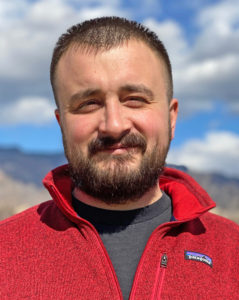
Sebastian Medina
January 4, 2022
Sebastian Medina, biology professor and alumnus of Highlands University, is on a roll. In 2021 alone, he published eight research articles and one book chapter that investigate the correlation between arsenic and anemia, and the effects of arsenic and uranium on immune system disorders.
Medina, who began teaching at Highlands University in the fall of 2020, said he loves research, and he credits his mentor, former natural resources professor Edward Martinez, for this passion.
Medina grew up in Mora and began his undergraduate studies at Highlands in 2008. He said he met Martinez through a work study job, where he was doing office work for an administrative assistant.
“Meeting Edward was a really big moment for me. His mentorship was instrumental in the discovery of my unknown passion—at the time—for scientific research and ultimately on my decision to stay in academia,” said Medina.
Martinez said he often saw Medina at his work study job and invited him to shift his work study to the research lab.
“I stole him from that admin assistant, because I knew that he liked the outdoors and that he was majoring in biology,” said Martinez. “So, Sebastian started helping me in the lab and doing research in the lab and out in the field when he was a freshman.”
Martinez said he gave Medina a lot of responsibility early on and, as a sophomore and junior, he began training other students, including graduate students, in the lab. In Martinez’s view, the early introduction to instruction helped Medina learn how to communicate complex topics clearly, and he said the two of them would often read scientific papers together with Medina sometimes writing the literature review for Martinez’s articles.
“Attending Highlands, even at the freshman level, students have these types of opportunities with some faculty,” said Martinez. “He was getting a lot of experience that graduate students get, but he was getting it as an undergrad. Senior year, he and a couple of others published a couple of papers as well, so going into graduate school he already had two publications under his belt.”
After pursuing his master’s degree at Highlands, Medina went on to complete a doctorate in biomedical sciences at the University of New Mexico, which he completed in 2019. Medina completed his post-doctoral research at UNM as well, and he said he maintains a strong collaborative relationship with his team and the laboratories there. Many of his UNM collaborators are co-authors on his recently published research.
Medina’s early research alongside Martinez looked at the effects of heavy metals on aquatic systems, but Medina said he later became interested in how these same metals affect human health.
“To me, the most compelling thing about research is that it’s sort of a puzzle, and so I get to play detective,” said Medina. “Every time you get a clue, it leads to a new clue and that leads to a piece of the puzzle being put in place. The more pieces you get, the more complete the picture gets.”
This year, Medina’s research has focused on how arsenic contributes to anemia, and the effects of arsenic and uranium in triggering immune system disorders.
According to Medina, arsenic is a widespread pollutant that can be found in water and in foods such as grains.
“We are interested in environmentally relevant exposures to arsenic, which are levels of exposure similar to what people would experience in drinking water,” said Medina.
Medina said high levels of arsenic are naturally occurring in water systems across the Southwest. He said people in rural areas are most at risk for consuming high levels of arsenic since well water is not regulated the way municipal water systems are.
“People in rural communities are especially at risk of consuming drinking water that is potentially laced with arsenic over long periods of time,” said Medina. “And we know, based on lots of scientific evidence, that these types of exposure result in many different health issues—things like cardiovascular disease all the way to a variety of different cancers.”
Medina said his research on arsenic and uranium largely aims to understand how these metals disrupt molecular and cellular pathways within red blood and immune cells in ways that contribute to adverse health outcomes—with the ultimate goal of figuring out innovative strategies to mitigate risk and health issues associated with arsenic exposure.
For Medina, research allows him to feel that he’s a part of something much bigger than himself, and he credits his work with Martinez at Highlands and with his colleagues Ke Jian Liu and the late Scott Burchiel, at UNM, with the volume of his output. Medina said the studies continue to evolve and he hopes to establish an independent research program at Highlands and maintain a working pipeline for students at UNM and Highlands, so they have a variety of research opportunities.
Medina said he has several mentees of his own.
“I’m hoping to spread my love of discovery and genuine curiosity for what’s going on around us,” said Medina. “Kind of like what Edward did with me.”
